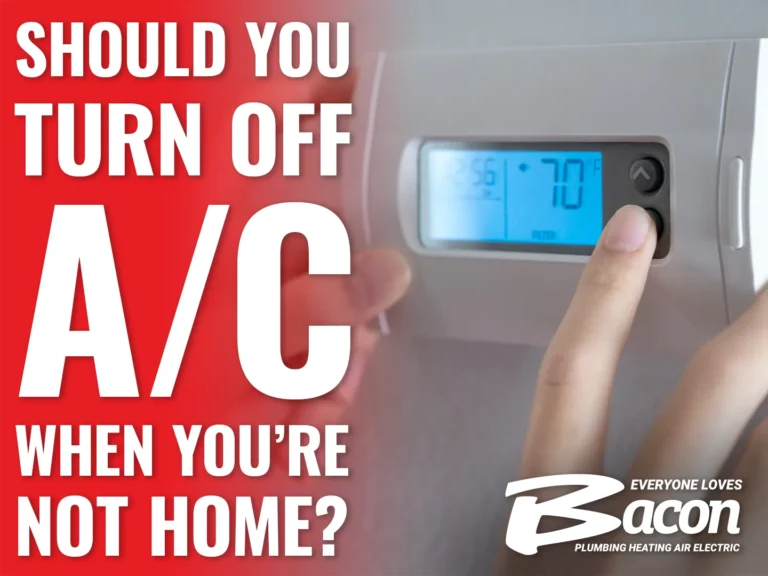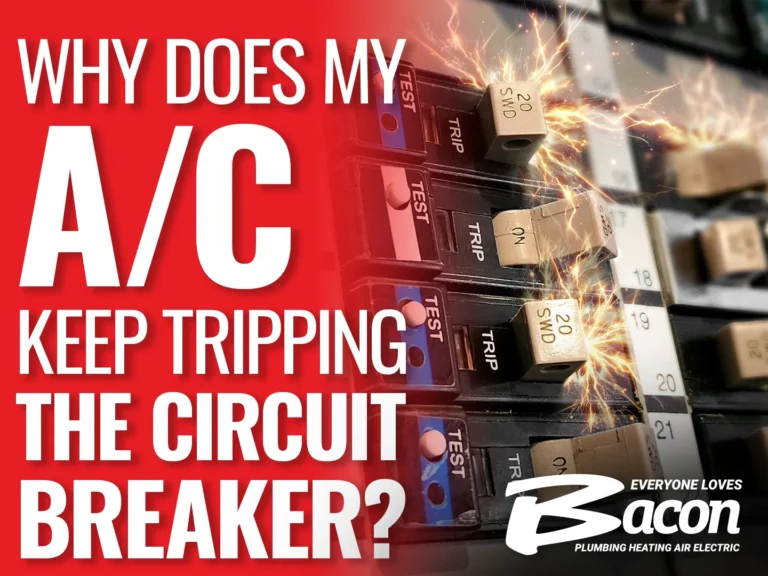If your air conditioner sounds like it’s working but the air coming out isn’t cool, you’re not alone. This is one of the most common AC problems homeowners face, especially during warmer months when you rely on your system the most.
The good news? Many of the causes are easy to understand, and in some cases, you can fix the issue on your own. In this guide, we’ll walk you through the most common reasons your AC is running but not cooling, how to troubleshoot the issue, and when it’s time to call a professional.
Whether it’s a clogged filter, a thermostat setting, or a more serious repair, this article is here to help you get your comfort back.
1. Dirty or clogged air filter
A dirty air filter is one of the most common reasons your AC runs but doesn’t cool your home properly. The filter’s job is to trap dust, pet hair, and other debris before they reach your heating or cooling system. But when it gets clogged, it blocks the airflow your AC needs to work efficiently.
Less airflow means less cool air, longer run times, and higher energy bills.
Read more: What You Need to Know About Your Air Filters
2. Frozen evaporator coil
Your evaporator coil is the part of your AC that pulls heat out of the air inside your home. When everything is working right, warm air passes over the coil, the refrigerant inside absorbs the heat, and cool air is pushed back through your vents.
But when the coil freezes, ice forms and blocks the airflow. Your AC keeps running, but it can’t cool properly.
How to tell if your coil is frozen:
- Weak or no airflow from vents
- Warm air instead of cool
- Ice on refrigerant lines or the indoor unit
- Water around the air handler from melting ice
This usually happens when there is not enough airflow or an issue with the refrigerant flow. A dirty air filter, low refrigerant, or a faulty expansion valve could be to blame. If you have a frozen evaporator coil or your AC unit is showing signs of ice buildup, find out what to do if your AC unit is frozen.
3. Blower Motor/Capacitor Failure
Your blower motor is what pushes cool air through your home. If it fails or the capacitor that helps it run goes bad, your AC may still turn on. However, you won’t feel much, or any, airflow from your vents.
In some cases, the motor may wear out over time or overheat. In others, the capacitor (a small part that stores energy to help the motor start and run) loses power and can’t keep the motor going. Electrical issues, bad bearings, or internal motor failures can also cause the system to shut down.
Signs of blower or capacitor issues:
- Weak or no airflow, even though the outdoor unit is running
- The AC shuts off shortly after starting
- Buzzing or humming noises from the indoor unit
- A burning smell or signs of overheating
What to do:
If you notice any of these signs, turn off your system and call a technician. Continuing to run your AC with a failing motor or capacitor can cause more damage to other parts of the system.
4. Ductwork Integrity Compromise
Even if your AC is running perfectly, damaged or poorly connected ductwork can stop cool air from reaching the rooms in your home. If ducts are disconnected, damaged, or leaking, your system loses airflow, which means less comfort and higher energy costs.
Common duct issues include:
- Disconnected sections, especially near the air handler or plenum
- Collapsed flexible duct lines blocking airflow
- Leaks in an attic, crawlspace, or wall cavities
- Ducts that are too small or too long for your system to handle
- Not enough return airflow, which throws off system balance
What to do:
If some rooms are hotter than others, or you’re not getting strong airflow anywhere, your ductwork may be the issue. A technician can inspect hidden areas and recommend repairs or adjustments to restore proper airflow.
5. Electronic Control Failures
AC systems rely on a series of electronic controls to keep everything running in the right order. If something in that system fails, such as a control board, thermostat signal, or safety switch, your AC may continue to run but won’t cool properly.
For example, your compressor might turn on, but the indoor blower doesn’t. Or the system might shut off early, blow warm air, or only cool certain zones.
6. Clogged or Dirty Blower Wheel
The blower wheel is the part of your AC system that moves air through the ducts and into your home. Over time, dust and debris can build up on the blades, especially if the air filter hasn’t been changed regularly.
When the blower wheel gets dirty, it can’t move air as efficiently. That means weaker airflow, more strain on the motor, and higher energy use. Left unchecked, the buildup can also throw the wheel off balance, leading to vibrations, noise, and long-term wear on your system.
Signs of a dirty blower wheel:
- Weak airflow even after changing the filter
- Unusual noises from the air handler
- Higher-than-normal energy bills
- Reduced cooling in multiple rooms
7. Hidden Blockages Inside the System
Sometimes, airflow problems aren’t about dirty filters or disconnected ducts—they’re hiding inside your air handler. Internal restrictions can quietly reduce airflow and cooling power without showing obvious signs.
For example, if a UV air purifier or damper is stuck in the wrong position, it can partially block airflow. At other times, issues like bent coil fins, a clogged secondary heat exchanger (in systems with a furnace), or narrow transition sections within the system can slow things down more than you expect.
These restrictions often don’t get noticed until cooling performance drops across the whole house.
Read more: How HVAC Dampers Work and How They Affect Flow
8. Thermostat Settings or Placement Problems
Sometimes, your AC’s airflow seems off, but the real issue is with your thermostat.
If the thermostat is set incorrectly or isn’t reading your home’s temperature accurately, your system may not turn the fan on when it should, or it may shut off too soon. In heat pump systems, mode confusion, such as using emergency heat by mistake, can also cause cooling problems.
In some cases, it’s not a setting at all. A thermostat placed in direct sunlight or near a heat source can skew the reading, causing your AC to run less frequently or at the wrong times.
Things to check:
- Make sure the fan is set to AUTO, not ON (which runs the fan continuously)
- Check that your system is in cooling mode, not emergency heat
- Avoid placing the thermostat near windows, lamps, or electronics that give off heat
- If airflow cuts in and out randomly, the wiring or fan relay may need a technician’s attention
If you’re considering switching out your thermostat, it may be time to consider a smart thermostat.
9. Pressure Imbalances in the System
Your AC system needs balanced airflow in and out to work properly. When that balance is off even slightly, it can create extra pressure inside your ductwork that slows down your blower and reduces overall performance.
This kind of imbalance can happen for a few different reasons:
- Too much air being pushed out, and not enough being pulled back in (supply/return imbalance)
- Running powerful exhaust fans while the AC is on
- Multi-zone systems with dampers that close off certain areas, building backpressure
- Filter grilles or return vents that are too small for the system’s airflow needs
- DIY system changes (like adding new ducts) without adjusting the airflow setup
Read more: What is Air Balancing?
10. Low-Voltage Control Problems
Your AC relies on a low-voltage (24V) control circuit to tell each part of the system when to turn on, how long to run, and in what order. If something in that circuit goes wrong, your system may run out of sync, or not at all.
These issues can be tricky because they often show up as random or inconsistent behavior. For example, your blower might not turn on when it should, or the system might fail to start altogether. The problem could be a failing transformer, damaged wiring, or even a mismatch in how power is delivered across multiple components.
Possible signs include:
- AC won’t start or shuts off early
- The fan runs, but no cool air comes out
- Intermittent or inconsistent operation
- The thermostat appears powered, but doesn’t activate the system
When to Call a Professional for an AC Not Blowing Cold Air Issue
Some AC problems, like a clogged air filter or an incorrect thermostat setting, are simple enough to fix on your own. But if your system still isn’t blowing cold air after checking the basics, it’s time to call in a professional. Certain issues require specialized tools, training, or certification to be diagnosed and repaired safely. Here are the most common signs it’s time to bring in an expert:
- Refrigerant issues: Ice on refrigerant lines or poor cooling performance could indicate a refrigerant leak or low charge. This requires specialized tools and EPA certification to handle safely.
- Electrical problems: Issues with the capacitor, blower motor, or control board can be dangerous to diagnose without training. A professional can test and repair these components safely.
- Compressor trouble: If the outdoor unit is noisy, shuts off frequently, or won’t turn on, your compressor may be failing. This core part needs expert evaluation.
- Recurring or complex issues: If your system is aging or you’ve had multiple breakdowns, a pro can assess whether repair or replacement is the smarter long-term choice.
- Unclear root cause: Some problems need advanced diagnostics. HVAC pros use specialized tools to pinpoint issues you can’t see or test yourself.
Preventive Maintenance to Avoid Future Problems
The best way to avoid an AC that runs but doesn’t cool? Stay ahead of issues with regular maintenance.
A professional spring tune-up can catch and clean buildup on the evaporator coil or blower wheel, test the control board and capacitors, and clear the condensate drain of all common causes of cooling failure. In the fall, a check-up helps prepare your heating system and ensures internal airflow stays unrestricted year-round.
If your system runs heavily, is older than 10 years, or lives in a coastal climate, ask your HVAC technician about more frequent inspections. The right maintenance plan now can save you from surprise breakdowns later.
AC Not Blowing Cold Air? Call Bacon Plumbing Heating Air Electric
If your AC is running but not blowing cold air, don’t sweat it—Bacon Plumbing Heating Air Electric is here to help. Whether it’s a simple fix or a more complex issue, our certified HVAC pros will get your system back to cooling quickly and reliably.
We offer expert AC repair and preventive maintenance services throughout the DFW and greater Dallas–Fort Worth areas, as well as Houston and its surrounding communities. With locations in Rockwall, Fort Worth, Plano, and Spring, we’re always nearby and ready to respond when you need us.
When you call Bacon, you’re getting more than a quick fix. You’re getting a team that values transparency, quality work, and long-term comfort. Schedule your service today by calling and stay cool with confidence.



